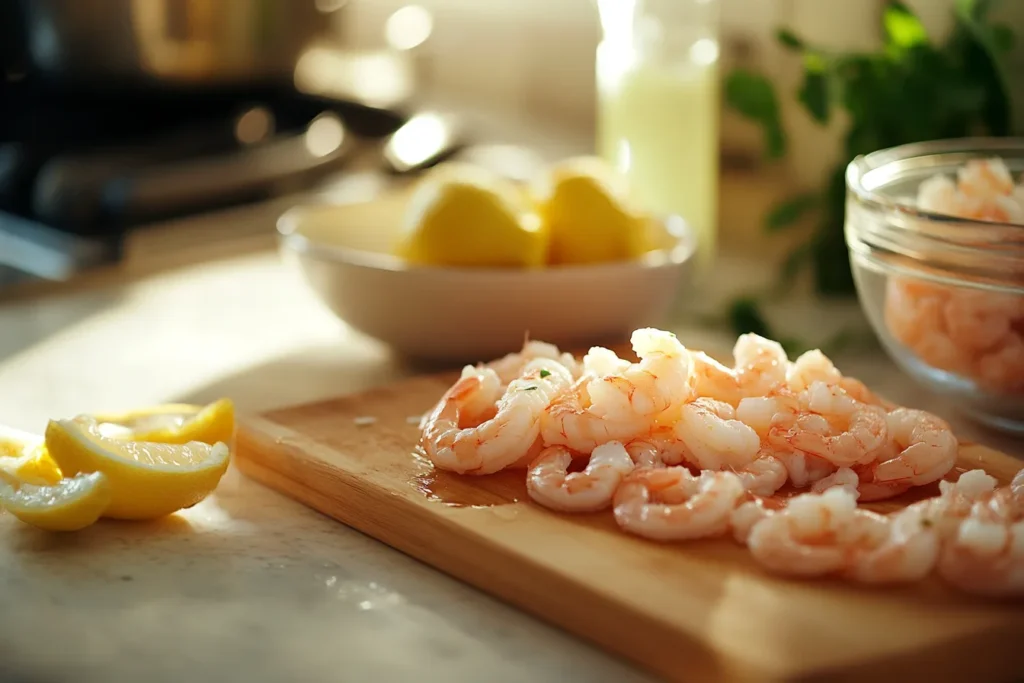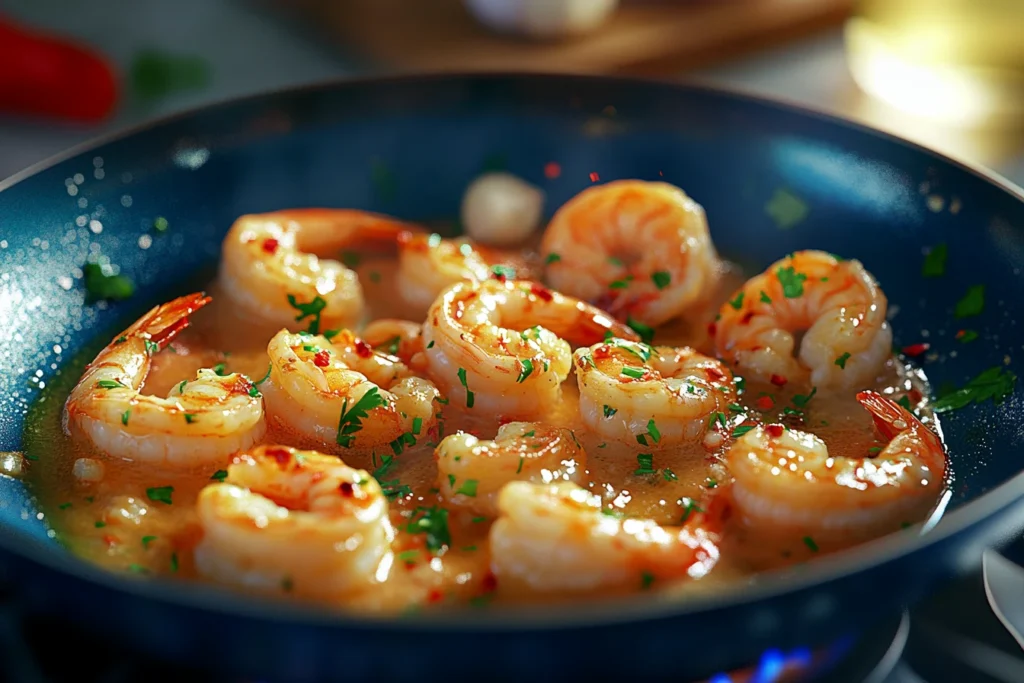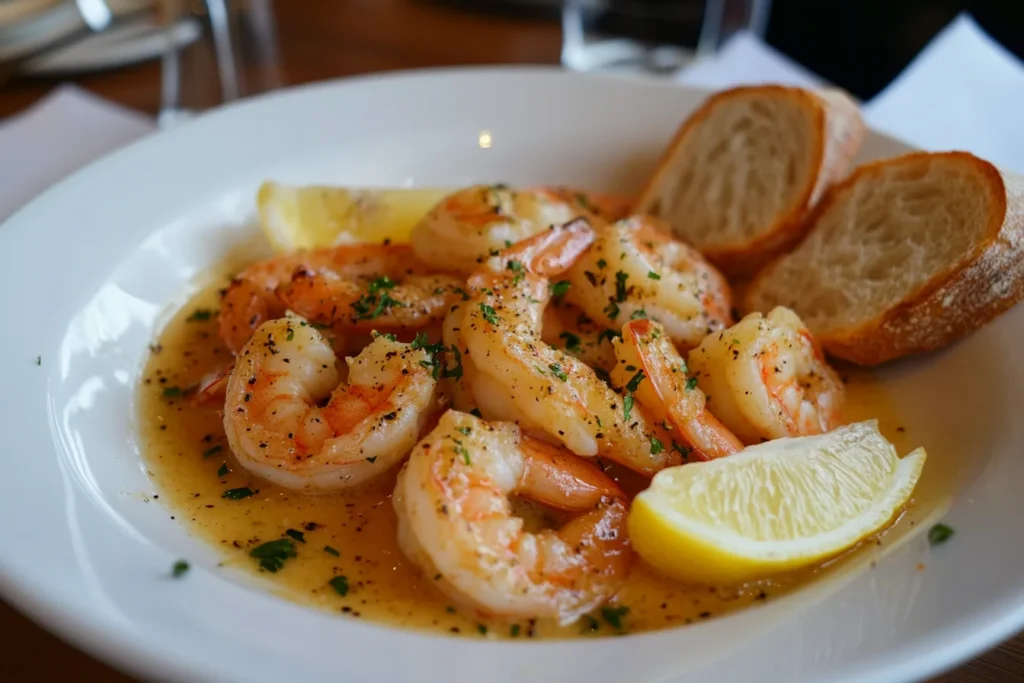What’s the tastiest way to cook shrimp? Shrimp is like the little black dress of the seafood world—it’s versatile, quick to cook, and pairs well with just about everything. But let’s be honest, not all shrimp recipes are created equal.
Whether you’re grilling, sautéing, or tossing them into pasta, finding the best cooking method is all about bringing out their sweet, briny flavor while keeping that tender, juicy texture. For instance, if you love bold flavors, you might enjoy our Shrimp Garlic Butter recipe or learn What Is Shrimp with Garlic Sauce Made Of? to try something deliciously new.
If you’ve ever overcooked shrimp into chewy sadness (hey, we’ve all been there!) or if you’re just looking for fresh ideas, you’re in the right place. Let’s uncover the secrets to cooking shrimp to perfection every single time.

Table of Contents
Understanding Shrimp Varieties
Before you even start cooking shrimp, understanding the different varieties is key to picking the right ones for your recipe. Not all shrimp are created equal—they vary in size, flavor, and texture, and each type works best for certain cooking methods. Let’s break it down:
- Cold-Water vs. Warm-Water Shrimp
Cold-Water Shrimp: These are typically smaller and sweeter, with a delicate texture. They’re perfect for chilled dishes like shrimp cocktails or salads.
Warm-Water Shrimp: These tend to be larger with a firmer texture, making them ideal for grilling, frying, or hearty pasta dishes. - Fresh vs. Frozen
Fresh Shrimp: Fresh shrimp can be incredible if you live near the coast, but they spoil quickly. If you’re buying fresh, cook them the same day for the best flavor.
Frozen Shrimp: Most shrimp are frozen shortly after being caught, locking in freshness. They’re a great option, and bonus—you can always have some on hand! - Shell-On vs. Peeled
Shell-On Shrimp: Cooking shrimp with the shell on enhances flavor and helps prevent them from drying out. They’re perfect for boiling or grilling.
Peeled and Deveined: These are super convenient and ideal for quick recipes like stir-fries or shrimp scampi. - Sizes Matter
Shrimp are labeled by count per pound (like 16/20 or 31/40). The smaller the number, the larger the shrimp. Jumbo shrimp are great for grilling or baking, while smaller shrimp are ideal for soups or curries. - Farmed vs. Wild-Caught
Wild-Caught Shrimp: Known for their robust flavor, these are usually pricier but worth it for dishes where the shrimp is the star.
Farmed Shrimp: Widely available and budget-friendly, but look for responsibly farmed options to ensure quality and sustainability.
What’s the Tastiest Way to Cook Shrimp? Preparing Shrimp Like a Pro
Getting shrimp ready for cooking is an essential step that can make or break your dish. Properly prepared shrimp not only taste better but also cook evenly, ensuring that juicy, tender texture everyone loves. Here’s a comprehensive guide to help you prep shrimp the right way:
- Thawing Frozen Shrimp
If you’re using frozen shrimp (a popular choice for convenience), thawing them correctly is crucial. The best method is to let them sit in the fridge overnight. For a faster option, seal the shrimp in a plastic bag and submerge them in cold water for about 20–30 minutes. Avoid using hot water, as it can partially cook the shrimp unevenly. - Deveining Shrimp
Deveining isn’t strictly necessary but is highly recommended for a cleaner presentation and better texture. The “vein” is the shrimp’s digestive tract. To remove it, make a shallow cut along the back of the shrimp with a paring knife or deveining tool, then gently pull the vein out. Rinse the shrimp under cold water to clean thoroughly. - Peeling Shrimp
For certain recipes, like soups or stir-fries, peeling shrimp in advance is best. To peel, hold the shrimp by the tail and crack the shell near the top. Gently pull it away in one piece, leaving the tail on if desired for presentation. - Drying the Shrimp
Always pat your shrimp dry with a paper towel before cooking. Moisture prevents them from browning properly, leading to steaming instead of searing. Dry shrimp result in that beautiful, caramelized exterior. - Marinating for Flavor
Shrimp are excellent at absorbing flavors, and a quick marinade can elevate their taste. Combine ingredients like olive oil, garlic, lemon juice, and spices for a simple marinade. Let the shrimp sit for 15–20 minutes, but don’t overdo it, as acidic marinades can break down the texture. - Using Uniform Sizes
To ensure even cooking, select shrimp of the same size for your recipe. This prevents some pieces from overcooking while others remain underdone.
Cooking Methods for Shrimp: What’s the Tastiest Way to Cook Shrimp?
Shrimp are incredibly versatile, making them a favorite ingredient in kitchens everywhere. From quick weeknight dinners to elegant dishes for special occasions, there’s no shortage of ways to cook these little seafood gems. Here’s a breakdown of the most popular cooking methods and when to use them:
- Sautéing
Why It’s Great: Sautéing is quick and allows for precise control over cooking. It’s perfect for dishes like shrimp scampi or stir-fries.
How to Do It: Heat oil or butter in a skillet over medium-high heat. Add seasoned shrimp and cook for 2–3 minutes per side until they turn pink and opaque. Avoid overcrowding the pan for the best sear. - Grilling
Why It’s Great: Grilling adds a smoky flavor and is ideal for large shrimp or skewers. It’s a summer favorite for shrimp tacos or surf-and-turf meals.
How to Do It: Marinate shrimp, thread them onto skewers, and grill over medium heat for 2–3 minutes per side. Brush with extra marinade for added flavor. - Boiling
Why It’s Great: Boiling is simple and works well for shrimp cocktails, salads, or pasta. It’s a go-to method when cooking in bulk.
How to Do It: Bring a pot of salted water to a boil. Add shrimp and cook for 2–3 minutes until they float and turn pink. Quickly drain and submerge in ice water to stop the cooking process. - Baking
Why It’s Great: Baking is a hands-off method that’s perfect for stuffed shrimp or casseroles. It’s great for evenly cooking large batches.
How to Do It: Preheat the oven to 375°F. Arrange shrimp in a single layer on a baking sheet, season, and bake for 8–10 minutes. - Frying
Why It’s Great: Fried shrimp are a crowd-pleaser, delivering crispy, golden bites. It’s ideal for appetizers or po’ boy sandwiches.
How to Do It: Coat shrimp in flour, egg, and breadcrumbs, then fry in hot oil (350°F) for 2–3 minutes until golden brown. Drain on paper towels. - Steaming
Why It’s Great: Steaming preserves the shrimp’s natural sweetness and tenderness, making it ideal for healthier meals.
How to Do It: Place shrimp in a steamer basket over boiling water. Cover and steam for 5–6 minutes until pink and cooked through. - Broiling
Why It’s Great: Broiling cooks shrimp quickly and adds a slightly charred flavor, perfect for garlic-butter shrimp or kebabs.
How to Do It: Place shrimp on a baking sheet, brush with butter or seasoning, and broil on high for 2–4 minutes. Watch closely to prevent overcooking.

Flavor Pairings for Shrimp
Shrimp are a blank canvas, ready to soak up whatever flavors you throw their way. Their mild, slightly sweet taste pairs well with a variety of ingredients, making them the star of countless dishes. Here are some of the best flavor pairings to bring out the deliciousness of shrimp:
- Garlic and Butter
A classic pairing that never fails, garlic and butter complement shrimp’s natural sweetness. Whether it’s garlic butter shrimp, scampi, or a simple sauté, this combo is a go-to for a reason. - Citrus
Lemon, lime, and even orange juice add brightness and acidity, balancing shrimp’s richness. Squeeze fresh citrus over grilled or pan-fried shrimp, or marinate them in a citrus vinaigrette for a tangy kick. - Spices and Herbs
Spices: Paprika, cayenne, cumin, and chili powder add warmth and depth. These are essential for Cajun or Mexican-style shrimp dishes.
Herbs: Parsley, cilantro, basil, and dill bring fresh, fragrant notes. Sprinkle them on just before serving for a burst of flavor. - Asian Flavors
Shrimp shine in Asian-inspired dishes with ingredients like soy sauce, sesame oil, ginger, and garlic. Toss shrimp in teriyaki sauce, serve in a Thai curry, or pair with tangy peanut sauce for a delicious twist. - Creamy Bases
Creamy sauces like Alfredo or coconut milk-based curries work beautifully with shrimp. Their rich texture contrasts perfectly with shrimp’s tender bite. - Pasta and Grains
Shrimp pairs wonderfully with pasta, rice, and even quinoa. Garlic butter shrimp over linguine or spicy shrimp with Spanish rice are crowd-pleasers that never disappoint. - Tropical Flavors
Mango, pineapple, and coconut bring a tropical vibe that complements shrimp’s sweetness. These flavors are ideal for salsas, tacos, or skewers. - Tomato-Based Sauces
Whether it’s marinara, spicy arrabbiata, or a light tomato broth, shrimp pair perfectly with tomato-based sauces. They absorb the sauce’s flavor while adding a juicy, meaty bite. - Cheese
Parmesan, feta, or cotija cheese can elevate shrimp dishes, adding saltiness and richness. Sprinkle cheese over shrimp pasta or baked shrimp for extra indulgence.
Creative Shrimp Recipes: Discover the Tastiest Way to Cook Shrimp
Shrimp are a culinary chameleon—they take on flavors beautifully and can be used in everything from quick weeknight meals to impressive dinner party dishes. Here are some fun, creative shrimp recipes to inspire your next seafood feast:
- Garlic Butter Shrimp Zoodles
Swap out pasta for zucchini noodles in this light and flavorful dish. Sauté shrimp in garlic butter with a splash of lemon juice, then toss with spiralized zucchini. Garnish with parsley and Parmesan for a low-carb twist on shrimp scampi. - Shrimp Tacos with Mango Salsa
Spice things up with shrimp tacos! Season shrimp with chili powder, cumin, and paprika, then pan-sear until golden. Serve in warm tortillas topped with fresh mango salsa (mango, red onion, cilantro, lime juice) and a drizzle of chipotle crema. - Coconut Shrimp Curry
Transport your taste buds to the tropics with this creamy dish. Simmer shrimp in a sauce made from coconut milk, garlic, ginger, curry powder, and a splash of lime juice. Serve over jasmine rice with fresh cilantro on top. - Shrimp and Grits
A Southern classic that never disappoints. Cook creamy cheese grits and top them with shrimp sautéed in a smoky bacon and garlic sauce. Add a sprinkle of green onions for extra flavor and a pop of color. - Shrimp-Stuffed Avocados
For a fresh, no-cook recipe, hollow out ripe avocados and fill them with a shrimp salad made from cooked shrimp, diced cucumber, red onion, and a tangy yogurt dressing. Perfect for summer lunches or appetizers. - Shrimp Fried Rice
Takeout at home is easier than you think! Toss shrimp with rice, scrambled eggs, peas, carrots, soy sauce, and sesame oil. This quick, one-pan dish is perfect for using up leftover rice. - Honey Garlic Shrimp Skewers
Marinate shrimp in a mix of honey, garlic, soy sauce, and a touch of sriracha, then thread them onto skewers and grill until caramelized. Serve with a side of grilled veggies or a fresh salad. - Shrimp Spring Rolls
Roll shrimp, fresh herbs, rice noodles, and julienned veggies into rice paper wrappers for a refreshing appetizer or light meal. Pair with a peanut dipping sauce for the ultimate flavor boost. - Creamy Shrimp Alfredo Pizza
Combine two favorites—pizza and shrimp! Spread a creamy Alfredo sauce over pizza dough, sprinkle with mozzarella and Parmesan, and top with cooked shrimp and spinach. Bake until bubbly and golden. - Shrimp Ceviche
For a no-cook option, marinate shrimp in lime juice until opaque, then toss with diced tomatoes, red onion, avocado, jalapeño, and cilantro. Serve with tortilla chips for a fresh, zesty appetizer.

FAQs About Cooking Shrimp
How do I know when shrimp are cooked?
Shrimp are done when they turn pink and opaque with a C-shape. Avoid overcooking, as they’ll become rubbery.
Should I cook shrimp with the shell on or off?
It depends! Shell-on adds flavor and prevents drying out, while peeled shrimp are easier to eat and ideal for quick recipes.
What’s the best way to thaw frozen shrimp?
Thaw shrimp in the fridge overnight or quickly in cold water for 20–30 minutes. Avoid hot water, as it can cook them unevenly.
Why do my shrimp taste rubbery?
Rubbery shrimp are overcooked. Shrimp cook fast—usually in 2–3 minutes per side. Keep a close eye to avoid overdoing it.
Conclusion: Finding Your Favorite Shrimp Cooking Style
Cooking shrimp is all about matching their natural versatility with flavors and methods you love. From quick sautés to indulgent curries, there’s no wrong way to enjoy shrimp as long as they’re cooked just right! Experiment with different techniques, from grilling to steaming, and pair them with your favorite ingredients like garlic, citrus, or tropical fruits.
Whether you’re whipping up a light shrimp salad or diving into buttery shrimp tacos, the key is finding what works for your taste buds and lifestyle. With so many options, shrimp can easily become a staple in your recipe rotation. So, grab some shrimp and get cooking you’re bound to find a new favorite way to enjoy these tasty little gems!

